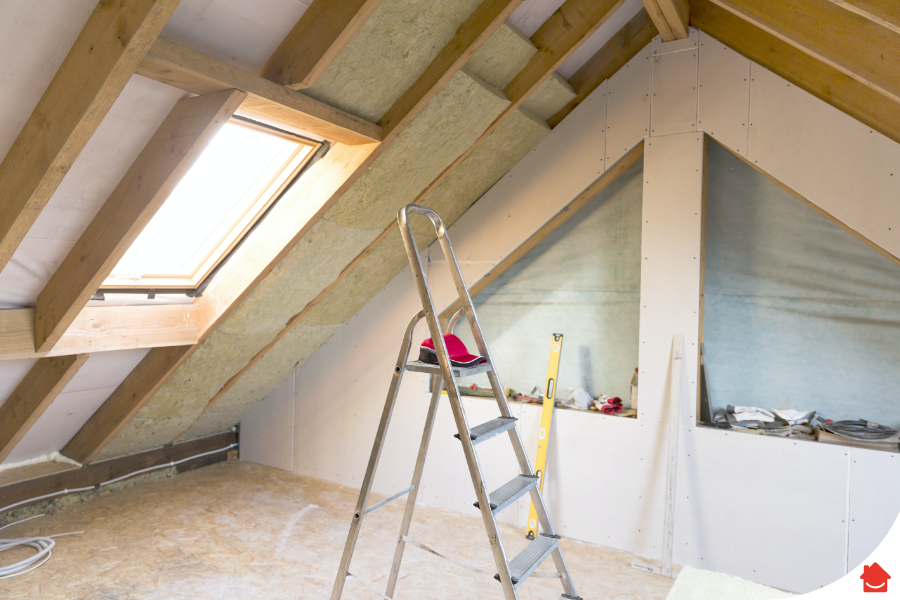Is your roof a snuggly warm nest for passing pigeons? If you haven’t insulated your loft, you probably have a few feathery freeloaders toasting themselves on the heat you’re losing through your roof. The Energy Saving Trust estimates that 25% of the lost heat from your home goes through the roof – quite literally, to reclaim your lost heat (and cash), you may want to consider insulating your loft.
This loft insulation guide will help you work out if loft installation is a sound investment for you, what the benefits are and if you’re so inclined, give you step-by-step advice on how to insulate a loft yourself.
If you’ve just started looking into insulating your home and want to prioritise your cost savings, start with our guide to insulate a house. Already know what you want to tackle first? Why not check out our cavity wall insulation and floor insulation guides for step-by-step instructions on installing insulation to save yourself from further heat loss in the home.
What is loft insulation?
Loft insulation is basically a barrier of material installed within your roof space to slow down the transfer of heat in your house from your living space and the outside world.
How does loft insulation work?
The material is either:
- Laid between the joists (the horizontal beams along the floor of your attic), stopping the heat coming into the loft space from your heated rooms below.
- Or it is laid between the rafters (the angled beams that support the roof) if you’re converting the loft into a warm living space (loft conversion) which is usually left to the professionals.
Installing loft insulation may be something you can do yourself, depending on your level of DIY mastery and on which loft insulation option you choose. Alternatively, you can hire a qualified specialist installer. Remember to always check for damp and condensation issues before starting loft insulation.
Benefits of loft insulation
- Long-lasting- Loft insulation should last you at least 40 years and pay for itself many times over.
- Cost-saving- How much is loft insulation? The Energy Saving Trust says a standard professional installation for a semi-detached house can cost you as little as approximately £300; estimating your energy bill savings at £150 a year, providing you install the optimum 270-300mm depth of insulation. So, in only 2 years you’ll have recouped your investment and started to save money. If you do it DIY, you could potentially spend only £50, which would mean you’d start to save after 6 months.
- Reduced carbon footprint – That same semi-detached house will now save an extra 610kg of CO2 per year – just from a £300 insulation job.
- Warmer in winter, cooler in summer – Just what it says on the tin. While it’s great for keeping your house toasty in winter, insulation can also ward off excess heat in summer.
- Increasing your home’s value – A well-insulated house means lower bills and a warmer home for potential future buyers.
- Improve your home’s energy efficiency rating – Always good for attracting those potential buyers in the future. Read more on energy-saving tips for the home here.
Loft insulation options
There are many different types of loft insulation, all varying in cost, durability and insulating performance:
Traditional insulation material
This is the most commonly used insulation type for easily accessible lofts. Available in rolls and can include glass and mineral wool, or sheep’s wool (both are readily available, with sheep’s wool slightly more expensive). This is suitable for simple DIY jobs where you can access the space easily and there’s no damp or condensation issues.
Top tip: to work out how many rolls of insulation you need, calculate the area in m2 (length x width = number of metres squared) and check the coverage of the rolls. Take off around 10% to allow for ceiling joists.
Sustainable choices
Also available in rolls, these include Earthwool (which is pricier than mineral or glass wool, but not quite as expensive as sheep’s wool) and other Eco-friendly or recycled materials.
Multifoil insulation
Multifoil insulation is made using multiple layers of aluminium foil alternated with breathable foam wadding. It was developed for commercial use following its success in the NASA space programme – so if it’s good enough for NASA, it’s good enough for your loft.
Multifoil insulation can also be a sustainable choice, if you opt for one made from recycled materials. It’s also available in a range of thicknesses so you can choose what’s best for your loft.
Other choices
- High-Density Foam Board – best left to the professionals for warm loft conversions and the underside of the roof, these firm boards of natural or synthetic insulation can be easily decorated over, but they tend to be more expensive than other options.
- Blown-fibre – used by professionals between joists, great for hard to reach places but again on the pricier side.
- Loose-fill insulation – a lightweight material made from recycled newspaper, cork granules or cellulose fibre it is best for topping up existing insulation or along irregularly spaced joists.
For a loft that’s easy to access, has regular loft joists and no damp or condensation problems, it’s certainly easy to DIY this one using rolls of soft insulation such as mineral wool or eco-wool.
DIY or pro loft installation?
If you’re not sure your insulation job is simple or more complex, check through the following to see whether it can easily be done yourself or it’s a job for the professionals.
Topping up existing insulation
Some homes already have insulation in between the loft joists, but it doesn’t quite hit the current building standards or is no longer optimal. The National Insulation Association says the recommended depth for loft insulation to maintain those impressive cost and energy savings is 270 millimetres for glass wool, 250 millimetres for rock wool and 220 millimetres for cellulose.
If this is you, usually you can ‘top-up’ your insulation yourself. Simply, measure the depth of the existing insulation. Ideally, it needs to be 100mm deep and come up to no more than 25mm above or below the joist. You can then lay the second layer of 170mm over the top of the joists to get you to the recommended building regulations guide of 270mm.
Using floorboards for storage
If you want to use the loft for storage, you’ll need to lay boards over your insulation – and there needs to be 50mm clearance between that and the board to prevent moisture and condensation, so you may need to raise the boards with storage stilts. Depending on your DIY competence and loft space, this usually doesn’t require a professional.
Warm loft – Loft for living space
If you want your loft to be a living space, you’ll need it to be warm. To do this, you have to insulate on your sloping roof, between the rafters. This can be a more complex task than standard insulation between the joists. Remember you’ll need to insulate not just the rafters but also the party walls and gable walls, as well as any other uninsulated parts of the room. Otherwise, all your heat (plus money and effort) will waft through one of those gaps. We recommend you outsource a warm loft job to seasoned professionals.
Insulating hard-to-reach spaces
This is a job for a professional installer, who uses specialist equipment to blow granules of cellulose fibre or mineral wool insulation into your loft, then treats it to make sure it’s fire retardant. This generally takes just a few hours, depending on the size of your loft.
Insulating a damp loft
We suggest getting professional advice from a builder or damp expert before you consider a loft insulation project. Talk to them about sorting out the damp before you think about insulating the loft. Insulating between the joists will make your loft colder, which could make the damp worse. So if you decide to insulate your loft you may also need to increase the amount of ventilation, and in that case, you’ll need Building Control Approval.
Flat roof
If you have a flat roof (pitched at less than 18°) you need to take a different approach. You can either choose a warm roof, which is when the insulation is placed on top of the roof, or a cold roof, which is when the insulation is placed between and under the joists. This is also definitely one for the pros.
How to get loft insulation
If you’re looking for a professional installer, the National Insulation Association (NIA) website is a great place to find members in your area who follow the NIA code of professional practice.
Loft insulation grants
If you are eligible for the government’s Green Homes Grant scheme. It’s designed to help homeowners in England with the cost of installing anything that could be considered ‘green’ and sustainable. You can apply for vouchers worth up to two-thirds of the cost of making your home more energy-efficient – up to £5k per household. To check if you’re eligible, visit the website.
How to install loft insulation
This guide will cover how to lay loft insulation roll and floorboards. At the risk of repeating ourselves, if you’re looking for warm loft insulation or more complex installations such as insulating in restricted spaces, or prepping your loft as a living space, we do recommend you call a professional.
Fit a cold-water tank jacket and pipe lagging before you insulate
If you have a cold-water tank and pipes in your loft it’s important to protect them before you insulate your loft, as it will soon be a colder loft. Essentially you need to:
a) Measure your cold-water tank in advance.
b) Buy an appropriate tank jacket and pipe lagging material
c) Fit the tank and pipe insulation before you start laying the loft insulation.
Read ‘How to insulate your water tanks and cylinders’ for a more in-depth guide.
DIY loft insulation installation
If you’re going to install loft insulation yourself, you can buy loft insulation material in varying types and thicknesses from all of the major hardware stores, along with accessories like storage stilts for raising your boards. You can get more specialist types like eco and multifoil insulation online.
What you’ll need
- Insulating material – Once you’ve decided on your chosen insulation material, think about the amount you might need. Remember, the gap between most home’s joists is usually 400mm or 600mm, so loft insulation rolls tend to be 1140mm in width. Most insulation material rolls come with pre-cut perforations so you can easily cut them into halves or thirds to suit your space.
- Snap-off knife or panel saw – You’ll need to cut pieces of insulation or board to fit your exact joist measurements.
- Crawling boards – If you’re planning on now using the space for storage, you can buy loft panels or crawling boards from most hardware stores.
- Storage stilts – If you are using crawling boards and want to keep a 50mm ventilation gap to ensure good airflow and avoid damp you can add these stilts.
- Protective equipment – Goggles, mask and gloves are suitable for this job.
- Staple gun – The portion of insulation that goes over your loft hatch can be kept secure and neat by wrapping it in some of the plastic packaging your insulation comes in, or a plastic carrier bag. Just secure it in place with a staple gun or some large-headed tacks.
- Duct tape – For pipe lagging.
How to lay loft insulation
If your loft joists are regular, you can use rolls of insulation:
- Lay the first layer between the joists – the horizontal beams that make up the floor of the loft.
- Then lay another layer at right angles to the first layer, to cover the joists and make the insulation up to the required depth – it needs to be 270-300mm (27-30cm) deep. This equates to a Thermal Resistance R-Value of 6.1.
Top tip: insulate around electric cables. Insulation shouldn’t be laid over any electric cables. Clip them to the roof joists if you can or gently move them out of the way whilst you install, before placing them back over the insulation once you’ve laid it.
How to lay insulated loft floorboards
A boarded loft is a great decluttering tactic. With some extra storage space in the loft, you get more usable space within your home, potentially increasing its selling value, as well as giving you a better environment to live in. Begin by removing any stored items so the space is clear from clutter and use good lighting where possible.
- Measure up
Measure the area you’re going to board so you can calculate the number of loft boards you’ll need. - Buy the materials
You can buy different types of loft boards, including moisture-resistant chipboard, general-purpose hardwood plywood and others, online. You may also need to purchase supports or stilts if you need to create the required 50mm of clearance between your insulation and the boards. The materials can cost as little as £300, depending on the size of your loft. - Fit your supports (if you need to raise your boards)
First, attach the supports to your ceiling joists.
Space them about 1m apart. - Now install the loft boards
a) Lay the first loft board across the joists.
b) Make sure the end of the board does not overhang the joist. If it does, cut it to ensure that it only reaches the centre point of the joist, so that you’ll still be able to fix the next board securely to the joist.
c) Use around 2-3 screws per join.
d) Now lay the other loft boards. Lay them in a staggered, brick-like pattern to give the whole boarded area more strength and stability.
e) Keep checking that the tongue and groove connections are fitted properly. - Add infill where required – You can’t avoid leaving a few gaps in your boarding as you continue with the staggered pattern. But you can fill these gaps in with pieces of infill, which you can cut as you go.
Top tip: You may need to use a hammer to lightly tap in the infill pieces before screwing them in.
Finding a professional installer
If you’re looking for a professional installer, the National Insulation Association (NIA) website is a great place to find members in your area who follow the NIA code of professional practice.
Common FAQs
Can you have too much loft insulation?
Yes. The optimal amount of loft insulation is 270-300mm deep. This ensures there is adequate ventilation. Over-insulate and you risk moisture and condensation getting trapped, which encourages mould to grow, which is a big no-no.
Should a loft be hot or cold?
A warm loft is required for a loft conversion. If your loft is going to be a living space it needs to be warm, so you insulate immediately under the roof, between the rafters. A cold loft can be used as a storage area or left alone. In this case, to save energy and money, you insulate immediately above the ceiling of the top storey of your home, so no heat from your bedrooms escapes into the loft and through the roof.
Should I remove old loft insulation?
Don’t remove old loft insulation unless you really have to. It’s a potentially hazardous job that’s best left to professional contractors. Topping up your existing insulation is perfectly adequate, making sure you reach the required depth of 270-300mm to get all the cost-saving benefits.
How to keep your home protected
At HomeServe, we know how important it is to protect your home – you can choose from a range of cover to protect your boiler and plumbing and we’ll help keep your home the perfect temperature all year round. Take a look at our boiler and plumbing cover options to find what best suits your needs.




